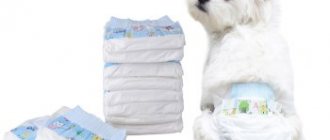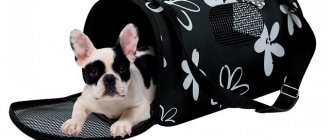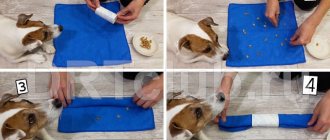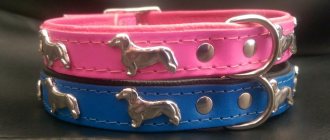Recommendations from dog breeders
Any pet you have reacts very sensitively to a positive attitude. In order for the dog to quickly get used to living in his new home, it is not recommended to close the cage at first. This should be done 2-3 weeks after the dog has adapted to the new place. If the animal enters the cage without any problems and stays there, then you should not try to remove it from there. Show care and try to praise your four-legged friend for every correct action. By doing this, you will help your dog feel comfortable and comfortable.
Use restraint when dealing with small puppies. Teach them to go to the toilet in a certain corner of the cage by preparing diapers or absorbent fabrics for this purpose. After being cooped up for a long time, the dog needs to increase the walking time as compensation. Remember that any animal will not become organized and obedient on its own. From a young age, teach your pet to maintain discipline, educate him.
To learn how to choose the right cage size for your dog, watch the following video.
Do you need clothes? Harness or collar, muzzle - which is better?
The Labrador Retriever has a thick coat and undercoat. Dense wool protects against sudden temperature changes and allows you to comfortably endure light frosts.
They don't need clothes for walking. A thick raincoat or raincoat for a walk in the forest in the off-season will provide additional protection for your dog from ticks and thorns. They will prevent the wool from getting wet when it rains.
The puppy is taught to walk on a leash with a harness. You can also start with a leash. The benefit of the harness is that it reduces strain on the neck thanks to the chest straps. The powerful body is under pressure. A harness is a great option for jogging.
In the city with a dog you need to learn to walk on a leash. Thanks to this, the dog feels every movement and squeezes harder.
How to care?
The animal must be kept clean. You can have two beddings. If you wash one of them, the dog will not feel discomfort, since inside the cage it will be on a comfortable, removable bed. You need to make sure that the water from the drinking bowl does not spill and the dog does not end up in a puddle. After your pet has eaten, food bowls should be removed from the cage.
Your favorite toys should be inside. You cannot punish an animal that is in such a house if it has hidden any of your things there. We need to calmly pick her up. If the dog is punished, then placing your pet back in the cage will be very problematic.
Contact with the owner
A dog crate in an apartment plays an important role in the psychology of the relationship between the pet and its owner. Especially if it is a guard breed, such as a shepherd dog, pit bull terrier or Rottweiler, which is obliged to obey only one member of the family, the one whom they consider the main one for themselves.
A crate helps raise a dog, since only the owner can let it out to go for a walk and spend time together. But you should not abuse the capabilities of the den and keep your pet there for a long time; you should limit yourself to only truly necessary moments.
Peculiarities
In the wild, dogs live in burrows they make themselves. These animals instinctively feel the need for privacy in different life circumstances. Domestic dogs also prefer their own dedicated space. From a young age, they get used to being in a cage or house, which you can place in your apartment in a place convenient for you, and also provide the animal with a comfortable bed for resting and waking.
Modern designers have developed a large number of models of apartment enclosures for dogs. If you have minimal knowledge in the field of carpentry and plumbing, then you can make a home for your four-legged friend yourself. A purchased or home-made home for an animal will give it the opportunity to feel safe. The pet will be able to move freely in it. If your dog has puppies, then there is no better place than a cage-house for their birth and feeding.
When you purchase more than one puppy, but more than two, it is best to keep them in a specially prepared medium- or large-sized enclosure. There they will not be constrained in their movements and will be able to actively grow and develop. All cages are made of materials such as compacted fabric, plastic and metal. Depending on the size and breed of your dog, the dimensions of your home enclosure are selected individually. The cage should have partitions that are removed as the dog grows.
Find the answer
Do you have any problem or question? Enter “Breed” or “Name of the problem” into the form, press Enter and you will find out everything about the issue that interests you. And of course, the most common thing that happens to dogs is simple carelessness: overturned terrariums, broken fish tanks, spilled pills, broken electrical cables - this is an incomplete list of dangers from which it is better to protect both yourself and your pet by locking it while you are not in the apartment or home.
Limiting your pet's restless activity is one of the mandatory requirements during air travel. For such expeditions, purchase durable plastic cages.
How to do it?
If you couldn’t find a crate suitable for your dog in the store, you can make one yourself. To do this, you need to know the height, weight and length of your pet. You can assemble an enclosure house according to the drawings provided on various sites on the Internet, or build it based on your personal preferences. For reliability, the cage can be easily welded using a welding machine if you have knowledge in this area.
To work you will need the following tools and materials:
- chain-link mesh with large or small links (depending on the size of your dog);
- wooden or metal beams in the amount of 12 pieces;
- furniture hinges, pliers;
- plastic side;
- construction stapler (staples);
- welding machine, if you use one.
The cell manufacturing process includes the following steps:
- choose the appearance of the cage according to ready-made drawings or make them yourself; determine its dimensions;
- a frame is made from wooden beams - it consists of 6 frames, four of which are intended for cell walls, and the other two go to the roof and floor;
- the finished base is covered with a mesh - it must be without flaws, since any damage can subsequently cause injury to the dog; it is attached to the beams using a construction stapler;
- the bars are connected using hinges that ensure assembly and disassembly of the cage; using them, the door is also fixed;
- the upper part of the mesh is covered with a plastic side;
- All frames are connected to each other and secured with a stapler.
This completes the construction of the cage. A completely metal cage is assembled in a similar way, only instead of a stapler, all parts are connected to each other by welding seams, installing hinges in the area of the door (or doors) of the cage.
Transportation
If the owner intends to travel a lot or simply move from place to place accompanied by a pet, then the cage will definitely come in handy. For the owner of the animal, as well as for the dog itself, this will be the most comfortable option.
Pets are different. Some people experience travel with anxiety, and a cage can give them peace of mind, as they feel protected in it. In addition, the owner’s car will not suffer from the consequences of their alarm. In addition, this will eliminate the need to look for a hotel for your pet or someone who will visit him if he stayed at home.
Owners whose dogs regularly take part in competitions and exhibitions know that a crate can also protect the pet from other animals in case of aggression, and will preserve its appearance and good mood.
The main thing to remember is that a dog crate in an apartment is not a place of confinement. You cannot leave your pet in it for a long time, otherwise he will become nervous, anxious and afraid of his home.
So that the dog feels its place from the moment it appears in the house, already strong puppies are accustomed to the den.
Advantages and disadvantages
There are a number of positive aspects in purchasing such a unique home for your beloved pet.
- If a small puppy is kept in a crate, then he needs it to ensure his own safety. In each apartment there are objects that he himself can ruin (tear, chew, throw). The owner will not be able to control the baby’s movements every second.
- When an animal is accustomed to living in a cage-house from an early age, it will not subsequently damage your furniture, for example, by chewing it. Such a dog will not scratch shoes or wallpaper, tear curtains to shreds, and much more. This form of keeping a pet disciplines him, he gets accustomed to the correct, unique manner of behavior in your apartment. Do not forget that a small puppy should not be left in a confined space for a long time. He should be placed in a closed cage for 3 hours a day until he grows up (up to 5–6 months). It is not recommended to leave the dog in the enclosure for more than 6 hours.
- A smart pet, as you know, will almost never go to the toilet in the same place where it sleeps and eats. Once accustomed to walking, it will wait for its owner and happily go for a walk. The exception is small puppies, who should be taught to go to the litter box from a young age or allowed to move around the apartment in those rooms where you consider it possible for you to be there. In this way, a dog placed in a crate house develops a daily routine, time for eating, walking and resting.
- The cage plays an important role in maintaining cleanliness in the apartment. If, for example, the pet was walked in rainy, damp weather, before washing the dog’s paws, it can be placed in an enclosure for a while. The cage itself must have clean bedding. It needs to be washed from time to time.
- If you have guests who are afraid of dogs or are allergic to wool, then in order not to spoil the evening and to protect strangers, you can temporarily lock the pet in its cage house.
- A dog accustomed to a crate feels good when traveling. In the house she is protected from other animals, for example, when it comes to trips to exhibitions, or hidden from contact with people, especially with inquisitive young children. There are animals that are afraid to travel in a car. By placing your dog in a crate, you will ensure that he can travel long distances without much stress. From the house, the pet will be able to observe the landscape around it and the main thing is to see its owner next to it.
The main disadvantage of an apartment enclosure for dogs is the fact that an animal such as a dog is quite mobile; being in a cage for a long time, it can become depressed. A growing pet needs constant movement for good development of skeletal muscles. Placing a puppy in a crate for 10-15 hours is out of the question.
Is it suitable for living in an apartment?
Active dogs, which include the Labrador, need adequate physical activity . First of all, the state of health, both psychological and physical, depends on this.
Any breed of dog can be kept at home if it is given proper attention. Frequent long walks, active outdoor games and training.
If the Labrador is not stressed, then in the first years of its life it will dump excess energy into destroying its home . How could it be otherwise if he is locked within four walls?
Over time, the dog imitates the lifestyle of its owners. Lazy people are not recommended to own Labradors. Without activity, dogs quickly gain weight due to metabolic disorders .
They become as lethargic as their owners, which is contrary to the nature of this breed.
Advantages and disadvantages
Before you start keeping a Labrador in an apartment, you should note several disadvantages of this decision.:
- the need to provide daily active load;
- the dog is recognized as a source of infections;
- the presence of long hair - during seasonal molting, the hair needs to be combed every day, intensive cleaning of the room and cleaning of furniture will be required;
- the need to devote a lot of time to the education process.
But all these disadvantages are fully compensated by certain advantages.:
- the appearance of a faithful friend;
- the labrador will happily go for a run with its owner in the morning;
- gets along well with children and can become a nanny;
- will not offend family members;
- With proper training, it performs security functions, although it is considered a completely non-aggressive dog.
What types of cells are there?
Having asked themselves this question, many people will probably think about a huge box that stands in the house and takes up a lot of space. However, this opinion is wrong, because there are many types of such structures. There are cages that are designed for keeping animals at home; yes, they are huge in size. But there are transportations that are designed to make the owner’s life easier while traveling. If you are the owner of large breeds, such carriages can be equipped with special wheels so that you can safely roll your dog to the car.
You can also find an exhibition cage tent - an ideal device for traveling by car to nature or competitions. Such an exhibition cage-tent can serve not only as a home for a pet, but also protects it from heat or rain. Such an exhibition device is more expensive than other types of cages, however, the price in this case is completely justified.
Options for purchased enclosures
Different types of enclosure designs are suitable for different breeds. They can be bought ready-made in specialized stores; such enclosures are designed for maximum convenience for small residents. Most models can be installed anywhere in the apartment and moved as needed.
For small dogs of miniature breeds, it is enough to buy an enclosure-playpen without a roof. This type of fence with mesh or transparent walls is also perfect for newly born puppies. The mother will be able to move around the house freely and see the offspring from afar, and the puppies will not be able to leave the playpen.
For small dogs, compact enclosures without a lid are suitable.
The aviary-cage is closed not only on the sides, but also on the top; it is chosen for a short stay of dogs of medium-sized breeds, for transportation, and representatives of small breeds are placed in such an aviary for permanent residence. You definitely need to install a toilet, lay down a soft mattress or diaper, mount fixtures and install bowls for food and water in them, put your pet’s favorite toys so that he feels comfortable.
The pet should be comfortable in the enclosure
We make the cage ourselves
You can make a cage with your own hands. Surely there is an old fence mesh or shell bed on the farm in order to make a home for your favorite animal with your own hands. Moreover, cages can be expensive, so making your own pet cage is a good option to save money.
First, you should take into account the size of your pet, so you can use the following recommendations:
- If the animal weighs less than five kilograms, it is worth making a cage with dimensions of 56 x 33 x 41 centimeters. These dimensions are well suited for Chihuahuas, Yorkies, Toy Terriers and other little ones.
- An animal from 7 to 12 kg will feel comfortable in a cage of 62 x 39 x 48 centimeters. Basenjis, Beagles, Pugs, Fox Terriers are breeds for which a crate of this size is suitable.
- For a pet weighing from 13 to 17 kilograms, build a device with dimensions of 77 x 49 x 53 centimeters, which is ideal for French Bulldogs, Cocker Spaniels, Miniature Schnauzers and so on;
- For huge pets, it is worth building a cage with dimensions of 138 x 95 x 115 centimeters. The large device is suitable for Neapolitan Mastiffs, Saint Bernards, Great Danes and others.
Tools and materials
- wooden blocks;
- mesh - for small breeds with small cells, for larger ones you can take more;
- plastic side;
- furniture hinges;
- construction stapler.
The amount of all materials will depend on the size of your pet.
Step-by-step instruction
- First you need to take measurements of your pet.
- Make your own drawings or just figure out how you would like the cage to look.
- We take wooden blocks and build simple frames according to the given dimensions with our own hands in accordance with the drawings. You need to make 4 pieces for the walls and 1 each for the floor and roof.
- From the inside, we cover the frames with a mesh with our own hands using a stapler.
- We cover the edge of the mesh with a plastic side over the fastening with our own hands.
- We connect the frames together.
- We fasten the side where the cage door will be with hinges.
- We put the dog's bedding and toys inside. Ready!
Diseases
Like all animals, dogs also get sick, the Beagle breed is no exception. They have a very strong immune system; with proper maintenance and care, diseases will rarely bother them. In good conditions they live 12–15 years. In general, they are resistant to illness and quickly overcome them, but during their lives there are times when they are unwell.
The most common
The most typical diseases for this breed include:
- obesity from overeating;
- genetic disease - epilepsy;
- chronic hepatitis;
- ear diseases;
- eye diseases;
- diseases of the musculoskeletal system;
- dermatitis.
All diseases are quickly curable in the early stages, so it is important to visit a veterinarian in a timely manner.
Rare
Of the rare varieties of the disease, such as:
- amyloidosis,
- hypothyroidism,
- cherry eye,
- deafness,
- cataract,
- glaucoma,
- congenital hypotrichosis.
Redness of the eyes
If red eyes appear, there is no need to panic. During the walk, grains or dust most likely got in. The first thing you need to do is wash your eyes with special disinfectants, such as Visine or Diamond Eyes. If after the procedure the redness does not go away, show it to a specialist.
IMPORTANT! Beagles are at risk for eye diseases. The symptom of red eyes may indicate cherry eye disease, which occurs when the lacrimal gland of the third eyelid prolapses.
Diagnosis will not be difficult based on the following signs:
- the mucous membrane turns red;
- swollen red glandular tissue can be seen from the inner corner;
- discharge and itching.
Red ears
There are no special problems with the ears if you take care of them and clean them on time. The cause of red ears may be an allergic reaction to food. The second reason is an inflammatory process or ear mites.
With inflammation and an allergic reaction, an unpleasant odor and plaque appears. With an ear parasite, the pet will periodically shake its head and scratch its ears. To eliminate problems, you should see a doctor.
Tail injuries
What do we know about the beagle's tail? The tail is a part of the body consisting of vertebrae, ligaments, tendons and muscles. According to the standard, it is thick, covered with a thick layer of wool, and looks like a brush. As practice proves, you should not pull a dog by the tail - it can injure you. In fact, there are many injuries that a dog can face.
The most common abnormal tail injuries are:
- Rolled over on the back - occurs due to increased muscle tone.
- Twisted - the reason is very strong and short ligaments.
- A knuckle is the fusion of one or more vertebrae to form a step upward.
- A fracture is a deformation opposite to a crease, the fusion of vertebrae step down.
- A bend is a defect that disrupts the center line of the tail.
- Nodulation is the fusion of wedge-shaped vertebrae to create a thickening of the tail.
Most tail injuries come from childhood - a genetic defect. When selling a puppy with a defect, most likely, sellers hide the truth, claiming that the tail was damaged during birth or pinched by a door. For a pet, a deformed tail does not cause concern, and he lives a full life.
A Beagle dog is an excellent option for those who can afford to spend a lot of time with the dog and educate it. She is very active, playful and devoted to her owners. Proper maintenance and care will allow your animal to avoid health problems and live for many years, enjoying its positive mood.
Why does a dog need a crate?
A cage for a dog is necessary, firstly, because in many ways such an animal is a predator, and they simply need a den. You've probably noticed more than once how your dog is looking for a secluded place under a sofa or closet. Secondly, even if the favorite is large, he is strong and formidable, but in many ways he is a child. The animal needs a personal space where it will not be disturbed.
Therefore, dog cages are an appropriate thing both in apartments and in yards. Moreover, many veterinarians believe that such a device can help with mutual understanding between the owner and the animal itself. This way you can strengthen friendship, because who, if not the owner, lets his pet out of the cage? Who then feeds him delicious food? He is the owner.
Naturally, with such maintenance a measure is necessary: you should not keep the animal in a cage all the time. But in the case where you have a little crazy person living with you who can do some mischief at night, why not lock him up. A crate is also necessary if the pet lives with a family where there is a small child.
Agree, protecting each other from extreme attention is very important
Cages are also required for transportation. Transporting a dog is a delicate thing, and a crate will allow you not to worry about the dog staining the entire car with its saliva or biting someone. There are many reasons where such a means of transportation would be appropriate, for example, transporting a pet to exhibitions and competitions. And at the event itself, the exhibition cage will come in handy.
Grooming. How long does shedding last?
The Labrador's coat is dense in texture, with a thick undercoat, thanks to which it tolerates low temperatures well and can swim in cool water.
In girls, shedding is more intense before estrus due to hormonal changes. Males change with the seasons.
Labrador Retrievers should not be cut or shaved. This disrupts natural heat exchange. In hot weather, the dog overheats, and in winter it freezes.
Labrador Retrievers need frequent brushing. The coat is constantly renewed; if the coat is not taken care of, the dog will develop skin problems.
To comb, use a comb with fine metal teeth. The Furminator is a comb with a small blade that gently thins hair and removes lint from the undercoat.
During shedding, your dog needs to be brushed every day. Shedding usually lasts a week or two. This is a painless period for the dog. A new coating is immediately formed.
Bathing while shedding will help the old coat fall off faster.
There is no need to change your diet. Vitamins in drops or tablets will help the animal’s body cope with this. Prolonged shedding with similar symptoms is a reason to consult a veterinarian.
Vaccination
Vaccination of Beagle puppies is a mandatory procedure that will provide strong, reliable immunity against deadly infectious diseases.
At 2.5 months, beagles are diagnosed with strains of distemper, parainfluenza, enteritis, hepatitis and leptospirosis.
At 6–7 months, the owner must vaccinate his beagle against rabies. Vaccination against these diseases is repeated annually.
Important! Two weeks before each vaccination, the beagle is dewormed. After vaccination, it is important to undergo a two-week quarantine, during which the pet should not be given antibiotics.











